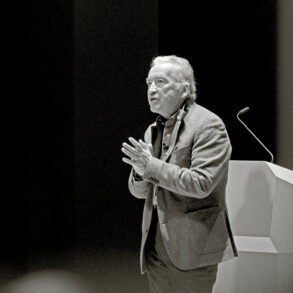For several centuries, scientific materialism neglected the experiential presuppositions of its own research activities, striving to achieve an outside, disembodied, “God’s eye view” of the universe. In their recent book, The Blind Spot,1 astrophysicist Adam Frank, theoretical physicist Marcelo Gleiser, and philosopher Evan Thompson offer a philosophical intervention into modern humanity’s techno-scientific civilization.
The authors argue that our contemporary scientific culture has steered us off course due to its lack of appreciation for the ultimately irreducible, immeasurable, and incalculable realities of such fundaments as time, life, and consciousness.
The Embodied Experience
The hero of the story is “embodied experience,” something as ephemeral as it is primordial. The authors analogize it to the blind spot at the center of our visual field caused by the passage of the optic nerve through the retina. Our embodied experience, rather than blinding us, is what enables us to see anything else, even if it usually remains hidden from normal observation. Far from being just another natural phenomenon that science might explain in objectivist terms, the authors argue that conscious experience constitutes science’s very condition of possibility: without experience, there could be no science.
The supposedly objective material stuff populating the universe of physics turns out to be the ideal construct resulting from an “ascending spiral of abstraction” that carefully filters out the messiness of real-world conditions. The vibrant and colorful natural world we encounter in embodied experience becomes sequestered in artificial laboratory conditions designed in accordance with formalized mathematical concepts.2 Such conditions may allow for greater precision in measurement and prediction, but this instrumental success comes at the cost of losing touch with the living relational context of the actual world-process.
The authors of The Blind Spot seek to restore human experience to its proper place at the very heart of the scientific enterprise. They make a compelling case that substituting abstract models for concrete reality leads not only to theoretical conundrums (e.g., the “quantum measurement problem” or the “hard problem of consciousness”) but has deleterious social and ecological effects as well.
Participatory Method
Students of German idealism and Naturphilosophie will recall that Goethe made nearly identical criticisms of Newtonian science in his Zur Farbenlehre (1810). As Rudolf Steiner says of the Goethean method: “Human knowledge is not a process taking place outside of the things, not a process springing from mere subjective arbitrariness, but rather: what arises there in our spirit as a law of nature, what expresses itself within our soul, is the heartbeat of the universe itself.”3
In alignment with the authors’ criticisms of representationalist theories of cognition,4 Steiner’s development of the Goethean method provides an alternative to the idea that knowledge is about building internal copies of external stimuli. Instead, human knowing is an intensification of what streams in from the perceptual world, a distillation of the essence of what is sensed, and a bringing to birth of the formative patterns pregnant in the world of the physical senses. Physical science only makes sense as an achievement of human intelligence informed by experience. The truth won through such a participatory method of knowing is not, says Steiner, “the coinciding of a mental picture with its object, but rather the expression of a relationship between two perceived facts.”5 Living concepts are not internal representations of sensory percepts (like logical or numerical models), but the means by which the metamorphic relations connecting percepts become transparent to our conscious thinking. From a participatory and phenomenological perspective, every scientific hypothesis must presuppose that its content is perceivable, if not by present experience, then at least by some future experience. Thus, “only hypotheses that can cease to be hypotheses have any justification.”6 The aim is not to replace experience with a model but to enrich experience itself. Steiner adds that “Science never has to bring something in addition to the phenomenal world, but rather only has to disclose the hidden interrelationships of this world.”7
The Experience of Time
After introducing the historical sources of the elision of experience in the development of modern mechanistic physics, the authors explore its lingering effects on contemporary cosmology. The nature of time takes center stage, as it powerfully illustrates the limitations of scientific measurement and calculation. Our actual experience of time includes both memory and anticipation: that is, real-time is not a series of simple, instantaneous presents that might be marked on a number line but a complex and irreversible flow of creatively differentiating moments. Steiner adds that “it is only to a completely mistaken understanding of the concept of time that the concept of matter owes its existence.”8
Unlike what Newtonian physicists had assumed, time is not merely an empty container in which the rearrangement of abiding material entities occurs. It is rather an expression of the self-organizing mutual dependence of perceptual facts upon one another, which proper scientific cognition can study systematically. Living nature—that is, nature as an embodied experience—is an ongoing process of transformation and metamorphosis with nothing substantial underlying it that abides all changes. “Matter is nowhere to be found within the world of experience,” according to Steiner. “Whoever wants to think matter must think it up and add it to experience.”9
Incommensurability
Despite the cogency of their criticisms of scientific materialism, one shortcoming of the book is that it does not provide much, if any, indication for what a more experientially adequate cosmology might look like. The Blind Spot authors could have deepened their own stated aims by entering into dialogue with, e.g., Steiner’s lecture cycle Interdisciplinary Astronomy (GA 323). The authors unwittingly reveal that the residue of model-centrism remains alive and well, even in their own thinking, when they contrast Aristotle’s geocentric universe with the supposed truth that Earth “really” goes around the Sun.10 To deny the heliocentric model of the solar system may at first seem like anti-scientific heresy, but it is well-known by astronomers that the Sun, like the Earth, is moving. Thus, the true relative motion of the Sun, Earth, and other planets is far more complex than the simple model of a static Sun-centered system that most of us have in mind.
Further, the fact that ratios of the planetary orbital periods can only be expressed with irrational numbers (those with infinitely non-repeating decimals), leads Steiner to argue that if they had a simple integer ratio, cumulative disturbances would eventually cause the planetary system to come to a standstill, to die. This incommensurability in the ratio of orbital periods is therefore essential for the ongoing life and stability of the planetary system. It prevents the planets from falling into a predictable and ultimately destructive pattern. In other words, what the authors of The Blind Spot argue about living organization and conscious experience in the biological world—that they are noncomputable—turns out to be true at the astronomical scale, as well.
An Exemplification of the Spirit
The authors conclude their book by calling for a reintegration of the human being back into the cosmological picture that scientific materialism had sought to remove us from. If the pursuit of an objective view from nowhere is no longer to be its ideal, then science must be reformulated in participatory terms: “we must inscribe ourselves back into the scientific narrative as its creators. Science rests on how we experience the world.”11 As powerful new technologies emerge and threaten to irrevocably transform the human life-world, it is imperative that we remember our status as microcosmoi. The human is not an accidental epiphenomenon emergent from meaningless matter but an exemplification of the spirit latent in its cosmic origins.
Blind spot science has led our civilization to adopt a soulless cosmology where life and mind simply have no place. The authors of this book helpfully trace a more realistic critical history of modern science that lays bare the methodological maneuvers by which materialism came to be its default ontology. In so doing, they free us to pursue an alternative, participatory form of scientific understanding.
Image Earth. Source: Nasa
Footnotes
- Adam Frank, Marcelo Gleiser, and Evan Thompson, The Blind Spot: Why Science Cannot Ignore Human Experience, MIT Press, 2024.
- Ibid, p. xii-xiii.
- Rudolf Steiner, Goethean Science, GA 1, Mercury Press, 1988, p. 204.
- Frank, Gleiser, and Thompson, The Blind Spot: Why Science Cannot Ignore Human Experience, p. 163ff.
- Steiner, Goethean Science, p. 101.
- Ibid, p. 135.
- Ibid, p. 196.
- Ibid, p. 193.
- Ibid, p. 234.
- Rudolf Steiner, Interdisciplinary Astronomy, GA 323, SteinerBooks, 2020.
- Frank, Gleiser, and Thompson, The Blind Spot: Why Science Cannot Ignore Human Experience, p. 251.









